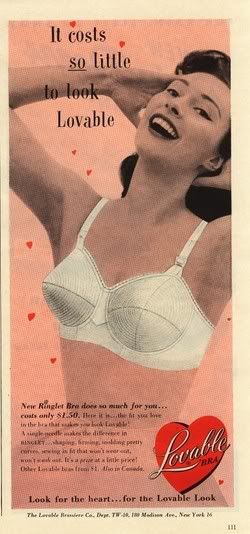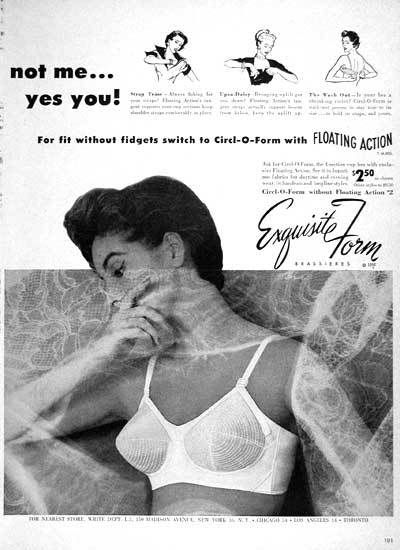How To Buy A Bra That Fits
by Michael Rabinowitz of Le Mystere
by Michael Rabinowitz of Le Mystere
Building a good wardrobe means dressing properly from the inside out, and the correct bra size is key. Wearing a bra that fits correctly affects posture as well as the health of the breast tissue (if the bra is too loose, the breast tissue sags; if it's too tight, the underwire can poke you in your most sensitive areas)-not to mention, breasts without the proper support can make you look heavier and older.
Your bra size can change for many reasons (from weight fluctuations to brand variations), so get regular fittings and replace your bras: every six months is ideal, every year is a must.
STEP 1: Determine your band size. While you are wearing your own bra, use a measuring tape to measure around the rib cage (just beneath the breasts), keeping the tape straight and snug around the back. If you measure an even number, add 4 inches to your measurement for your band size. If you measure an odd number, add 5 inches to attain your band size.
For example: Measuring 32 inches around the rib cage means the calculation is:
Measuring 31 inches around the rib cage means the calculation is:
Fuller figure women please note: If you measure more than 36 inches around your rib cage, you may need to add only 1 to 3 inches in order to get to the next even-numbered band size. If your rib cage measures 38-44 inches, you do not need to add and additional length.
STEP 2: Determine your cup size. Measure around the fullest part of the bust, keeping the tape straight and snug. Subtract this measurement for your rib cage measurement. The number is now the basis for your cup size. Cup size in the U.S. is calculated on ascending numerical scale starting at 1 in for an "A" cup. For every inch of difference, you go to the next cup size.
For Example: If the measurement around the fullest part of your breasts is 40 inches and your rib cage measurement is 36 inches, that means 4 inches is your cup size.
1 in = A cup
2 in = B cup
3 in = C cup
4 in = D cup
5 in = DD cup (E)
6 in = DDD cup (F)
7 in = DDDD cup (G)
STEP 3: Put on the bra properly. Never put on a bra by hooking it underneath your breasts and spinning it around so the closure is in the back. Instead, lean forward into the cups, lacing your breasts into the supports and reaching behind to hook the bra on the middle hooks of the closure.
STEP 4: Adjust the straps. If the straps cut deeply into the skin, find a bra with a thicker shoulder strap or a strap with a thin layer of padding or gel for comfort. Make sure to adjust the straps every time you put on a bra.
STEP 5: Now, determine the bra's fit.
Your bra size can change for many reasons (from weight fluctuations to brand variations), so get regular fittings and replace your bras: every six months is ideal, every year is a must.
STEP 1: Determine your band size. While you are wearing your own bra, use a measuring tape to measure around the rib cage (just beneath the breasts), keeping the tape straight and snug around the back. If you measure an even number, add 4 inches to your measurement for your band size. If you measure an odd number, add 5 inches to attain your band size.
For example: Measuring 32 inches around the rib cage means the calculation is:
32 in + 4 in = 36 inches
Measuring 31 inches around the rib cage means the calculation is:
31 in + 5 in = 36 inches
Fuller figure women please note: If you measure more than 36 inches around your rib cage, you may need to add only 1 to 3 inches in order to get to the next even-numbered band size. If your rib cage measures 38-44 inches, you do not need to add and additional length.
STEP 2: Determine your cup size. Measure around the fullest part of the bust, keeping the tape straight and snug. Subtract this measurement for your rib cage measurement. The number is now the basis for your cup size. Cup size in the U.S. is calculated on ascending numerical scale starting at 1 in for an "A" cup. For every inch of difference, you go to the next cup size.
For Example: If the measurement around the fullest part of your breasts is 40 inches and your rib cage measurement is 36 inches, that means 4 inches is your cup size.
1 in = A cup
2 in = B cup
3 in = C cup
4 in = D cup
5 in = DD cup (E)
6 in = DDD cup (F)
7 in = DDDD cup (G)
STEP 3: Put on the bra properly. Never put on a bra by hooking it underneath your breasts and spinning it around so the closure is in the back. Instead, lean forward into the cups, lacing your breasts into the supports and reaching behind to hook the bra on the middle hooks of the closure.
STEP 4: Adjust the straps. If the straps cut deeply into the skin, find a bra with a thicker shoulder strap or a strap with a thin layer of padding or gel for comfort. Make sure to adjust the straps every time you put on a bra.
STEP 5: Now, determine the bra's fit.
- Make sure your breast fills the cup completely, without spilling over the top. A bra is too small when you put on a shirt and see a "bump" where the breast meets the top line of the cup.
- If the cups of the bra are wrinkly, lift your breast and place it correctly into the cup. If after you readjust the cup, it is still wrinkly, the cup is probably too large. If your breasts bunch up on the sides, the cup is probably too small.
- Make sure that there is a plush covering on underwires for maximum comfort.
- The small piece of fabric suspended between the cups should lay flat against your breast bone.



No comments:
Post a Comment